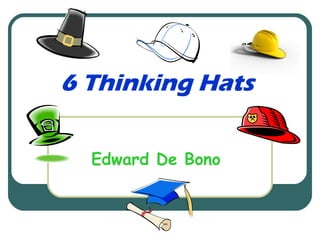
Six thinking hats edward de bano
- 1. 6 Thinking Hats Edward De Bono
- 2. Dr. Edward De Bono Edward De Bono is a world-known expert in creative thinking. The 6 Thinking Hats is one such technique. The main idea is to have the group only “wear one hat at a time” when considering a problem. The wearing of the hat is metaphorical. At any one time, everyone will wear the same colour, in other words, look at the problem at hand from only one perspective, the perspective indicated by the hat colour.
- 4. Yellow Hat Activity In small groups of 3: (Group Roles, Graphic Organisers) What are the good points of being tall?
- 6. Black Hat Activity In small groups of 3: Look at the All-Weather Bike. Read the and write what you think might be wrong with the design. Identify the weaknesses in this new kind of bicycle.
- 8. Red Hat Activity By yourself: Listen to this piece of music. Write down how this piece of music makes you feel? Music
- 10. White Hat Activity Small groups of 3: Look at the box and pretend that some one has bought you a pet. It is inside the box. Write down all of the facts you would like to know about this pet? Write all you questions in the space below.
- 12. Green Hat Activity Go back to the All-Weather Bike. We have looked at all the weaknesses of this new type of bike. Now go back and look at how we can overcome these weaknesses? Do you have any better ideas for an all weather bike? Draw or write your explanations on the back of the All-weather bike sheet.
- 14. The Unique Blue Hat The blue hat is different from the other hats because it is involved with directing the thinking process itself. We are actually using the blue hat whenever we suggest the next hat to be used. The blue hat need not be acknowledged at every turn however there are some points which it is often helpful i.e., 1. At the outset of a discussion – Lets decide what we want to think about and which hats we will use? 2. At a midpoint to restate the thinking goal – I think we are getting away from what we wanted to talk about. Can someone recall what we decided to talk about? 3. At the end to summarise what thinking has been done – Think of a sentence that tells about what we have been doing today?
- 15. Blue Hat Activity In a small group of 3: Complete the thinking steps map for FOX IN A FIX.
- 16. Single Hat and Sequence Use The hats can be used singly at any point in thinking. In general, this is the major use. The hats are used as a convenience for directing thinking and for switching thinking. Simple sequences of two or three hats may be used together for a particular purpose. For example, the yellow hat followed by the black hat may be used to assess an idea. The black hat followed by the green hat may be used to improve a design. (All Weather bike)
- 17. Yearly Overview Term Strategy Student learning outcome. 1 Six Thinking Hats Students can: (one at a time) Explain the thinking for each hat Practice orally the appropriate thinking for each hat Give example of the hats i.e. yellow hat ideas etc 2 Hat sequence Students can: (evaluation) Explain the evaluation sequence Employ yellow hat and black hat thinking 3 Hat Sequence Students can: (caution) Explain the caution sequence Effectively employ black hat and white hat thinking 4 Hat Sequence Students can: (Design) Explain the design sequence Effectively employ blue, green hat and red hat thinking.
- 18. Evaluation Sequence To discover the positive aspects and negative aspects of an idea. You use the yellow hat before the black hat. You could follow up with the green hat (new ideas) and red hat (feelings) thinking. Examples: Consider positive and negative Not doing homework one night. Swapping toys with friends.
- 19. Caution Sequence Looking critically at situations. You are first considering facts with the white hat. Then use the black hat to discover difficulties. This can be followed up with some blue hat or red hat thinking. Examples: consider the consequences Throwing most of your lunch in the bin everyday. Not letting someone know where you are going.
- 20. Design Sequence Encourage students to create new ideas, products or improvements to existing designs. Use the blue, green and red hats. Example: use design sequence to create A better toothbrush Alternatives to homework.
- 21. Other Sequences Red + White Comparing fact and opinion Black + Yellow + Green Comparing and synthesising (coming up with new ideas from the known) White + Blue What do we know (facts) and where are we going (planning)
